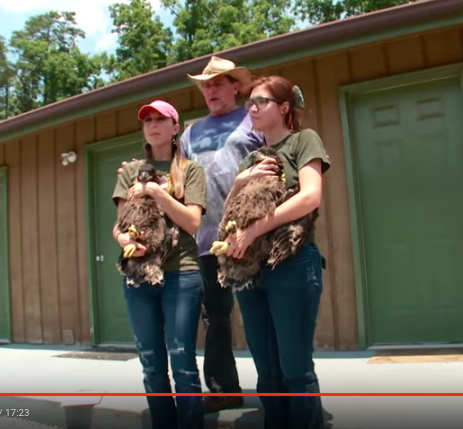[/av_textblock] [av_textblock size=” font_color=” color=” custom_class=”]
On June 16, 2013, the two 6-week-old eaglets from the nest of non-releasable Bald Eagles ‘Independence’ and ‘Franklin’ were taken to the American Eagle Foundation’s Hack Tower, overlooking Douglas Lake in East Tennessee. They will spend approximately 7 weeks in the Hack Tower, acclimating to their new environment and growing strong enough to fly free.
Tens of thousands of people around the country were able to see the eggs hatch and the eaglets being raised by their parents.
It is absolutely necessary to transfer the eaglets from the Dollywood Park environment to imprint them to much more typical bald eagle habitat that they can view from AEF’s Douglas Lake hack site.
This usually needs to be done between 5.5 and 6.5 weeks age, or whenever they can see over the top of their nest.
AEF constructs their nest with steep and somewhat high edges so that the eaglets can remain with their parents, and on camera, longer than otherwise. If the eagles are allowed to remain in the nest too long, they begin to climb atop the nest, as one already has a few times.
The transfer to the hack tower needs to be made just before the eaglet(s) begins to peer downward to the ground and Park at about a 45 degree angle. They could then possibly see AEF staff placing food on the ground inside the aviary, so that the eagle parents can deliver it to the eaglets in the nest. This could easily result in the eaglet’s permanently associating humans as their food source, and thus not learning to fish for themselves, and therefore risk starving to death.
Likewise, if the eaglets get too familiar with the Dollywood Park patrons by viewing them from 80 feet away for a few weeks, they would tend to lose their wildness to the degree that their well-being would be significantly diminished. One or both eaglets could therefore be transferred at any time to their survival in the wild.
Even under the best of conditions, only about 50% of eagles survive their first year in the wild (90 % each year thereafter), due primarily to their inexperience in the wild and lack of knowledge about threats to their survival.
In summary, we want to imprint our released eagles on typical Bald Eagle habitat where they can learn how to survive in the wild.
Contributed by Bob Hatcher: Eagle Consultant and Correspondent at American Eagle Foundation (AEF). Past: TN Wildlife Resources Agency (TWRA)
[/av_textblock]

